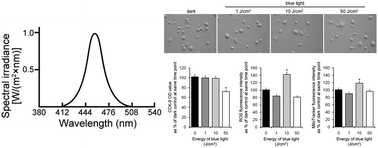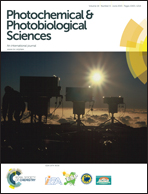Early changes in staurosporine-induced differentiated RGC-5 cells indicate cellular injury response to nonlethal blue light exposure
Abstract
Purpose: Blue light has been previously demonstrated to induce injury of retinal cells. The cellular responses to nonlethal blue light exposure for each type of retinal cell are of particular interest but remain undetermined. Based on the doses of blue light reported in previous research to be nonlethal to retinal pigment epithelial cells, here we investigated whether and to what extent such doses of blue light are cytotoxic to staurosporine-differentiated RGC-5 cells. Methods: RGC-5 cells were differentiated for 24 hours using 200 nM staurosporine. The resulting cells were cultured and exposed to blue light at three different energy levels (1, 10, and 50 J cm−2). Cellular morphologies were investigated with an inverted microscope and cell viability was assessed with a Cell Counting Kit-8 (CCK-8) assay. The generation of intracellular reactive oxygen species (ROS) was evaluated by H2DCFDA. After loading of MitoTracker Green FM dye, the mitochondrial contents were analyzed using flow cytometry. The lactate dehydrogenase (LDH) activities in the media were also measured. The level of lipid peroxidation was determined by measuring the amount of malondialdehyde (MDA). Results: Treatment of the cells for 24 hours with 200 nM staurosporine successfully induced the differentiation of RGC-5 cells. No morphological changes were observed in the ssdRGC-5 cells exposed to blue light at 50 J cm−2, which was the highest energy level tested. Exposure of the ssdRGC-5 cells to this energy level of blue light did, however, decrease their numbers by approximately 72.1% compared to the numbers of such cells found after being left in the dark. Remarkably, the levels of ROS generation and mitochondrial contents were, respectively, increased to 142% and 118% of those of the control by a 10 J cm−2 exposure of blue light. The LDH activities and MDA levels exhibited no obvious changes in the blue light-exposed ssdRGC-5 cells compared to the control cells. Conclusions: In vitro nonlethal blue light exposure led to cellular damage of staurosporine-differentiated RGC-5 cells. These increases in oxidative stress and mitochondrial content were the early steps of the cellular response to the exposure of relatively low doses (10 J cm−2) of blue light.


 Please wait while we load your content...
Please wait while we load your content...